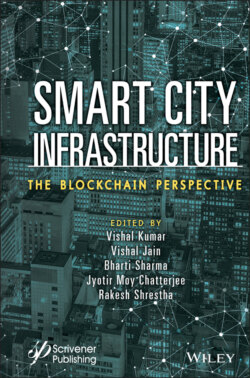Читать книгу Smart City Infrastructure - Группа авторов - Страница 14
1.1 Introduction
ОглавлениеBlockchain has gained tremendous popularity in recent times because of its fundamental properties and peer-to-peer operations. Blockchain theory was the future of well-known researcher Santoshi Nakamotos in 2008 with Bitcoin crypto-currency innovation. More than 2,500 crypto-currencies exist, but the authentic utilization of Bitcoin is still not explored effusively. Various issues like secure document transferring, anti-money laundering, decentralization, and authorized and unauthorized mining actions are near related to Bitcoin [1–5]. The Bitcoin system model nearly takes 5 to 8 minutes for the mining process and validation of the transaction, which plays a crucial role in numerous appliances such as industry, economics, supply chain management, healthcare, and the Internet of Things (IoT). In present situations, digital information streams from one-end to a new dissimilar end via an unauthorized transmission channel. Where securities models and privacy are the two significant worries in any transaction, blockchain produces a protected peer-to-peer broadcast. Moreover, all the transactions of blockchain publicly accessible for analyzing although none can amend the transaction one time it is recorded [1–6].
Blockchain is a scattered data catalog that monitors an emergent directory of transaction reports with systematizing them into a hierarchical series of blocks because of database management. Coming to safety potential, blockchain builds and maintains with peer-to-peer overlie setup and secured with intellectual, decentralized exploitation of cryptography techniques. Experts forecasted that blockchain-related annual revenue would reach approximately 22 billion dollars at the end of 2030, with an annual growth rate of 29.6%. Numerous distinguished organizations like Accenture, Cisco, Morgan Stanley, Google, Citibank, Ali baba, IBM and IT vendors, financial consultancies, and internet giants designed and developed a high-standard research laboratory to make a capital layout blockchain knowledge [3–6]. Moreover, blockchain with Artificial Intelligence (AI), Machine Learning (ML), and big data are considered the heart of computing skills for the upcoming generation financial inducts. A few governments have released methodological reports along with white papers on blockchain utilization for a positive approach. Some of them like the European Central Bank unconfined credentials on distributed ledger expertise, and the UK government liberated a fresh testimony that illustrates the outlook of distributed ledger technology. The Chinese administration liberated white papers on the blockchain tools besides improvement in China; the USA builds an authorized and authoritarian background for blockchain knowledge development. In academe, several documents are available on blockchain in the earlier period, consist of a dozen of the article, and provide information on safety then secrecy risks of blockchain. Furthermore, most of the safety then secrecy risk–based articles of blockchain-focused on uncovering attacks that suffer blockchain, and some target specific proposals for employing some current countermeasure adjacent to a subset of various attacks. Among these, very few attempts describe a complete investigation of the safety then confidentiality characteristics of blockchain along with different protocol implementation methods [2–8].
